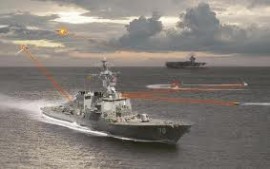All the gizmo freaks are drooling because the US Navy has supposedly demonstrated a fearsome new “ray gun,” the HEL, High Energy Laser, designed to burn planes, missiles or boats that get too close to surface ships. The trusting Dilberts over at Wired’s Danger Room just about came in their khakis at the news.
Those Wired guys don’t know a thing about how people really make war in the dirty parts of the world, but oh, they love their nice clean hi-tech gizmos.
Just listen to this hysterical start to their article:
“With clouds overhead in the salty air, irritable Pacific waves swelled to up to four feet. Perfect conditions, in other words, for the Navy to fry a small boat with a laser beam — a major step toward its futuristic arsenal of ray guns.”
Jeez, are these guys in fourth grade or what? Although I did like the bit about “irritable Pacific waves.” Nothing pisses off an ocean like having lasers tested on it.
Or maybe the Pacific just isn’t as liable to believe USN press releases, since its seen too many Navy boondoggles over the years. What you see so clear it’s painful in this Wired story is every eight-year old boy’s dream of that “arsenal of ray guns.” Lasers were the coming thing when I was a kid. I bet they were the coming thing for guys ten years older than me too, and ten years younger. In other words, they’ve been the coming thing for a Hell of a long time, but they never seem to arrive.
There are three simple things that the middle-aged kiddies at Danger Room try hard not to think about when they make their little lightsaber noises, imagining cool ray-gun battles in Da Fyuchah:
1. Air. It’s this thing, you can’t see it but—well, blow on your hand. Feel that? That’s air. Unfortunately we need it to breathe, and even more unfortunately it absorbs the energy of laser beams. The experts call that “blooming,” and it’s even worse when there’s any smoke or haze in the air. And gosh darn it, wouldn’t you just know it, it seems there’s this tendency for battlefields to be full of all this nasty smoke’n’haze stuff that gets right in the way of our cool ray-gun dreams. So unfair!
2. Energy. The same buzz-kill of an issue that stops us driving Caddies, and now it’s messing with our lightsabers. The sad fact is that with the power sources we have now, the old dream of a shoulder-fired laser rifle is impossible. You’d need to be Godzilla to carry the power pack, but then Godzilla’s already got eye-lasers, so maybe he’s using an internal frame pack. For now, the only lasers we have than can do more than fry an ant like a kid’s magnifying glass are gigantic, with even bigger battery packs—which is why they’re mounted on surface ships. The Pacific Ocean is maybe irritable because it’s gotta displace the ten-ton power pack this gizmo takes.
3. Weather. This is another really gosh-darn annoying thing that’s related somehow to #1, “air.” Apparently this “air” moves around and sometimes there’s water in it and if there’s any of this water in the air, lasers just don’t work, period. If this water-in-the-air thing is warm, they call it“rain” and the laser beam can’t poke through it. If it’s cold it’s this thing called “snow,” and that gets in the way too. Unbelievable! It’s like the whole planet is just trying to ruin all our fun!
Those are just the big three, the top contenders in a long list of reasons that grown-ups don’t waste a lot of time on ray guns. I’m not even talking about the problems with a pure line-of-sight weapon like a laser (hint: if you can see them, they can see you), or the fact that the beam creates a mist of melted target material that acts as an incredibly effective shield against further damage…or the real elephant in the Star-Wars room: the fact that we’ve got about a million boring conventional alternative weapons that can do the job now, without needing to imagine an engineering miracle.
Death Match: Laser vs. Plastic Outboard Cowling
If you actually see the video the US Navy released to show the magical boat-burning laser, you have to laugh at what a cheap, obvious fraud it is. I’m calling it out right now. I said FRAUD, and I mean FRAUD. In fact I can’t believe the gizmo fans have been naïve enough to buy this crap. The most obvious fakery in the video is the cuts. The video is 49 seconds long, but it has three distinct cuts: one at the six-second point, another at about 32 seconds, and a third at the 42-second mark. That means we don’t know the actual time required for this wonder weapon to set fire to an outboard engine—which my half-brother used to be able to do by accident in about a millisecond, without lasers.
Didn’t you hi-tech Danger Room fellas notice that? I guess you were too worried about that irritable ocean. Science just goes out the window when Star Wars comes onscreen, I guess.
So, maybe somebody could ask the Navy what the ACTUAL ELAPSED TIME is between the laser firing on the Evinrudes and the Evinrudes’ cowling catching fire.
Which raises another totally obvious problem nobody’s mentioned: IT’S A FUCKING PLASTIC EVINRUDE COWLING! OF COURSE IT CAUGHT FIRE! I COULD SET IT ON FIRE WITH THE SAME MAGNIFYING GLASS I USED TO FRY ANTS WITH! What if our no-fair future enemies play dirty by making their engine cowlings out of reflective metal? Gee, are they allowed to do that? What if they bring Mom’s dressing-table mirror and hold it in front of their engines? What if the dirty cheaters even go so far as to use INBOARD ENGINES!!!!! Oh No!
Every blogger or so-called journalist who swallowed this story should jump in the irritable Pacific, right now. There are just so many obvious questions they don’t ask, don’t even think about. Here’s one: “How long would it take a 57mm deck gun to blow up those outboard engines?”
Answer: the time it took for the shell to fly there. A whole lot less than the 49 seconds plus God knows how much time between cuts it took that laser. And a 57mm gun doesn’t take a battery the size of Manhattan, either.
All the services lie when they’re pushing programs, but the Navy lies most of all. In fact the Navy is the only one of the services that’s actually built around a lie, the carrier group. The carrier group should be renamed “Tomorrow’s Dive Site” because it won’t survive ten minutes in a serious war. Carriers are indefensible, period. That’s why we’re getting this noise about lasers: because even the surface navy, who survive by denying the obvious, have had to face up to the fact that carriers could not survive if they have to rely on their current defenses.
But look—I’m getting frustrated here, because it’s just so damn stupid—look, suppose we solve all the impossible engineering problems with weaponized lasers. They still wouldn’t save those dead-man-walking carrier groups. Maybe the US Navy and the Danger Room kiddies can’t think hard about this, but I can. I’ve already talked about how a low-tech swarm attack could destroy carriers, and lots of bloggers have mentioned the new Chinese ballistic carrier-killer missile, but those are just two ways to kill this bloated, helpless target. Suppose the Chinese get impatient and just detonate a nuke in the high atmosphere over a carrier group? I’m not talking about nuking them, thought that’s a totally plausible scenario, I’m talking about the EMP killing every system on the carrier group. Imagine the aftermath of that. They could come in on 31-foot Bayliners and attach limpet mines while the crew was trying to get the M-4 lockers open, then putt-putt off while the hulls blew open. Or Hell, they could TOW the damn things to the Shanghai scrap yards.
But we’re talking about a whole service that lives by not thinking about stuff like that. And that’s why they want you to believe in the Magic Laser.
Would you like to know more? Gary Brecher is the author of the War Nerd. Send your comments to brecher@exiledonline.com. Read Gary Brecher’s first ever War Nerd column by clicking here.
Click the cover, buy the book!
Read more: carrier, high energy laser, laser, navy, wired, Gary Brecher, The War Nerd


Got something to say to us? Then send us a letter.
Want us to stick around? Donate to The eXiled.
Twitter twerps can follow us at twitter.com/exiledonline


















66 Comments
Add your own1. CB | April 13th, 2011 at 9:46 am
Sorry Gary, I can’t hear you over the sound of CHARGIN MAH LASERS! Yay lasers! Pew pew!
2. dfasd | April 13th, 2011 at 10:07 am
Every blogger or so-called journalist who swallowed this story should jump in the irritable Pacific, right now
HAHAHAHHAHAHA. I loled in real life.
3. exploitedtimes | April 13th, 2011 at 10:15 am
Lasers. At least make a cool box for them if the Navy is going to mount them on deck. I posted about this at exploitedtimes.com, now the Navy can complete with Austin Powers versus Dr. Evil and his shark-mounted lasers.
4. Evilcor | April 13th, 2011 at 10:25 am
The first goddamn thing I thought of when I heard “Navy laser” was: what’s wrong with a deck gun? You know, the heavy-explosive lobbing terror weapon that flattens whole cities from over the horizon? Last I heard, those work great.
Of course they’re no good at all because nobody in authority will actually give permission to shoot a “civilian” boat until it’s waaaaayyyyy too late, so unless that stupid laser’s cool acronym lets it travel back through time it’s a total waste.
Business as usual, in other words.
5. abc123 | April 13th, 2011 at 10:32 am
Great article, but you are wrong about reflective materials. Even a perfect mirror wouldn’t do anything to stop a laser. The split second the laser beam hits the mirror it will lose all reflective ability.
6. whatever | April 13th, 2011 at 10:36 am
Do you even need a 57mm? Surely a standard sniper would do disable an outboard engine. (assuming we are just trying to stop the boat and not sink it)
My other though is that this weapon does not actually work full stop. Clearly it takes a while to burn through the engine Cover. Now imagine trying to hit that engine in one spot long enough to burn through the cover on a boat that is moving about in actual rough water (such as you get in wind on inland water), and not just bobbing gently on a small swell.
7. Thomas | April 13th, 2011 at 10:40 am
If you have an expensive floating target, you may as well have an AWESOME expensive floating target.
8. PJ | April 13th, 2011 at 10:40 am
Sure, lasers are worthless as weapons right now, but so were airplanes in 1914. The point is that, given (a lot of) development, they have the potential to add capabilities we currently lack. Your 57mm deck gun can’t shoot down that Chinese ASBM, for example, but lasers (theoretically) could.
9. J.T. Patton | April 13th, 2011 at 10:52 am
Think of all the $$$ spent on this FRAUD that could,ve been spent on the only effective ship there is- the submarine.
10. Ruthless Canadian | April 13th, 2011 at 11:05 am
This whole thing reminds me the episode of “MythBusters” when they tested Archimedes’ Death Ray. It didn’t work then, either…
I can imagine the Chinese brass ROFLOL at the news…
11. abc123 | April 13th, 2011 at 11:10 am
whatever: A 57 mm canon is an all around weapon used to defend against a number of threats.
It’s like a “jack of all trades, master of nones”.
It can shot small boats, small uavs, certain low velocity anti-ship missiles (the old kinds, likely to be in use with third world countries, of course it can’t handle new anti-ship missiles), prop-planes.
Essentially it’s a weapon to deal with all of those unexpected things that can happen in a modern battlefield, like a Swiss army knife, don’t leave the harbour without one.
12. lopsotronic | April 13th, 2011 at 11:18 am
I would think a deck-borne laser would be put to better use frying the sensor packages of incoming ASM.
13. DrK | April 13th, 2011 at 11:29 am
I think you’re being unfair here. A carrier group has a perfectly good strategic value. When your diplomats are asking some country for the right to use their airfields to bomb the fuck out of their neighbour, it allows you to say “look, we can just bring our carrier group in, but it’d be faster/cheaper to use your airfields, and naturally you’d get a cut of those savings–like not being included on the list of places to bomb”.
For fighting, yeah, they’re fucking useless, but for bluffing diplomats, they’re almost as good as they are at siphoning money to defense contractors.
14. Eddie | April 13th, 2011 at 11:29 am
This is what happens when you engage in stupid arms races. Sooner or later you run out of real technology and the only thing left is pure fantasy.
This by the way is perfectly captured by what some economists call the law of diminishing returns(I hold a great mistrust towards anything economists say but this one makes sense).
It is usually expressed in the form of an example.
We all know that fertilizer improves crop yields; but at some point, adding more and more fertilizer improves the yield less and less. There is even a point where adding more fertilizer actually decreases the yield. This is known as the point of negative return.
Here is the same law for ship sizes.
We all know that a missile can destroy any ship regardless of size. At some point adding more and more tonnage improves the capabilities less and less. There is even a point where by adding more tonnage all you are doing is spending more money and endangering more lives(negative return).
Here it is for tank armor. (Validated by WWII)
We all know that by adding weight you can increase the survivability of any tank. At some point adding more and more weight improves survivability less and less. There is even a point where by adding weight your actually decrease the survivability of the tank. (Slow and consumes far too much fuel)
Then there is this pesky thing called efficiency. The Germans learn this lesson during WWII.
By increasing the complexity of any tank your also inadvertently decrease your production numbers. If the Soviets can produce 3 tank in the time it takes you to produce 1 then your tank has to be at least 3 times as good on the battlefield to make any sense. (If you exclude the value of human life, and believe me it was excluded)
Or as comrade Stalin used to say: “Quantity has a quality all of its own”.
15. Jesse the Scout | April 13th, 2011 at 11:37 am
I think all that missile vulnerability ships are subjected to is part of why they’re playing with this stuff. Every one watched a lot of cartoons growing up and in the back of their minds they’re hoping someday the technology will advance enough to be knocking incoming missiles out of flight left and right like on some stupid giant robot anime. Of course, right now that’s like me pointing my garden hose down and imagining that some day I can use it like a jet pack to fly. There’s quite a bit of gap there, enough that I probably shouldn’t be getting my helmet out of the shed just yet.
16. Eddie | April 13th, 2011 at 11:39 am
The future is smaller, lighter, faster, stealthier ships carrying advanced missiles.
http://www.youtube.com/watch?v=LWh3PsfUMZw
17. pimp of the Balkans | April 13th, 2011 at 12:04 pm
So… which serious opponent is going to come over the horizon, let alone putter and bumble about while the US navy revs up its lazors?
Also, which commander is going to let a serious opponent approach to within a mile?
Or has a zillion megabucks been spent in order to find a new way to puncture some brown man’s zodiac? Hahahah that’s brilliant.
18. Mike | April 13th, 2011 at 12:08 pm
Just stop even pretending that you ever knew anything about hardware, or technology. All this ‘yeah I memorised pages of reference books…’. Maybe you did, maybe you didn’t, but whether you know stats or not you clearly don’t understand physics or engineering, so all you could do was compare those stats with no understanding. You embarass yourself most times you get into any sort of technical detail, but this article is the worst so far. Stick to talking about politics and psychology.
Briefly, the muzzle energy of a rifle bullet is only about a kilojoule. Burning a small hole through someone though someone takes 30-40 kJ, about the same as flash vaporising a glass of water. A typical laptop battery contains 300 kJ. The problem is not the power source, it is system efficiency.
Weather is an issue for long range lasers (which is why railguns are being developed for that role) but this is point defense. Pulsed lasers in the 100kW class, firing over a mile or two, easily creates a plasma channel that renders rain irrelevant.
You constantly go on about ‘ballistic missiles kill carriers’ without ever providing the slightest claim about how the guidance system on this Chinese missile is supposed to work, given that no one else has made a ballistic missile with terminal guidance worth a damn. Meanwhile you dismiss the effective and battle-proven defensive missile systems on the US ships, despite the fact that they have repeatedly demonstrated the ability to stop ballastic missiles (which are much easier to hit than surface skimmers, no horizon problem and they can’t evade, that’s the definition of ‘ballistic’).
19. hahaohwow | April 13th, 2011 at 12:43 pm
i googled “vulnerability of carriers”
found this site (second result btw):
http://blogs.howstuffworks.com/2009/04/07/us-aircraft-carriers-are-incredibly-vulnerable-to-attack/
the first link on that page goes to A WN ARTICLE
20. Skan | April 13th, 2011 at 12:58 pm
Wow, I mean, wow… all this article was, was a sad attack on another site. Wired, or gizmondo? I dunno, couldn’t read through all the hate… did someone on one of those sites forget to stroke your EPEEN? My God what a piece of crap.
But I’m not offended. Oh nosiree, I’m not offended at all. In fact, I’m not a shill for Wired, and I even pretended like I wasn’t sure if the War Nerd blasted Wired or gizmondo. But yeah, I’m totally fine, totally okay here. Just a guy who works for Wired, that’s all. Kill me, please.
21. Bane | April 13th, 2011 at 12:58 pm
There are S movies from 50’s about new fancy weapon called laser. It is old, old idea and after 30-40 years of development there still isn’t any practically apllication of it.
On the other hand, you have first plane made, and in less than 10 years from “totally uselles” thwt fot to Gotha heavy bombers bombing england and manuverable trippledecker dogfighters, and heavully armored albvatros attack planes.
Thats pretty fast develpment and practicall application time form me.
Bottom line – if they kant make it work in 10 – they wont make it work in 50 years.
ps. sorry bout my typing 🙂
22. Nor Word | April 13th, 2011 at 1:01 pm
I don’t doubt the lasers would be effective, but where exactly are they going to put the power plants for those things, in say an LCS?
The other thing is that the FELs and the optics are not going to handle saltwater and repeated heating cycles very well. You can’t press pause on an incoming swarm of cheap CHICOM re-entry vehicles until things cool enough again to allow your adaptive optics to work.
23. yawn, yawn | April 13th, 2011 at 1:04 pm
yawn. I’m big bad China and see Navy ships with lasers. So what?
In the end, sea and land superiority are meaningless since Afghanistan and Iraq have shown that America can be bankrupted by a bunch of dudes with AK-47s and a bunch of IEDs.
24. moorefire | April 13th, 2011 at 1:39 pm
@mike
So you have faith in the ability of a defensive missile system to neutralize a missile threat but don’t have faith in the ability of an offensive missile system to hit a warship? because of targeting problems?
That’s a much longer reach than lasers being an effective anti-ship weapon during our lifetime…
25. my talkative ringpiece | April 13th, 2011 at 1:47 pm
Takes HUGE banks of capacitors. There are other ways to generate the huge burst of electricity needed, all of them huge, you need a ship to carry them.
I *believe* there’s been some experimentation with C02 lasers that aren’t quite man-packable but are transportable by vehicles (are they still using the good old deuce-and-a-half?) and done kool things like blown maybe-terrorist-or-will-grow-up-to-be kids’ hands off etc.
The Sandbox. We’d call it Guernica but no one’s sure how to pronounce it.
26. Hanko | April 13th, 2011 at 1:51 pm
Hey, I’m not defending the laser (lasers are gay, unless they are really big), but could’t the development of the laser give a fast hitting weapon that takes out small ships at a relative small cost?
27. Zappa Ascendant | April 13th, 2011 at 1:52 pm
Love this post for a number of reasons Gary, but especially for putting the Danger Room fanboys in their place. Those guys are nothing but cheerleaders and sycophants for the world’s most heavily armed boy-scout troop…uh I mean the US military.
28. toumasho | April 13th, 2011 at 2:40 pm
Gary, you omitted something: the main objective of military lasers. Their nature is defensive. These lasers are not supposed to replace long range weapons systems. Their main objective is the fast neutralization of incoming missiles.
Example: Aircraft carrier is under attack, enemy has launched dozens of cruise missiles against it. This scenario is a guaranteed failure with the current defenses: Phalanx CIWS will run out of ammo in less than half a minute and just how many anti-missiles they have? There is no time to reload magazines when the rest of the swarm arrives and starts redecorating your carrier.
With FEL, not HEL, laser the scenario is reversed. 1MW continuous beam and target switching occurs in milliseconds. A MegaWatt beam punches through SIX METERS of steel per second. You just need to flash that thing to a missile and it has lost ten inches of steel that was supposed to mean something when delivered. Remember that the faster it goes the hotter its head already is. So, if the incoming object is already touching it’s physical limits, how much is needed to make it fail? Not much.
These are the exact reasons why your Navy and every other Navy in the world are either developing lasers or seeing wet dreams about them.
Key advantages from lasers:
– They do not run out of ammo.
– Target switching is blinding fast.
– They do not wear or erode like guns.
– Ballistic, skimming or what ever attack angle from between, no difference.
Well, I guess Chinese military planners are already developing swarming micro torpedoes. It is much easier to knock a blade out of AC propeller, it’s air force will be disabled when it loses its maneuverability. People still think you need to sink ships, not true. All you need to do is to make them limp and they are out of the equation.
29. Coriolan | April 13th, 2011 at 2:48 pm
Muskets took long to load, had a small fire range and were inaccurate. A trained archer could do 10 times more damages. Now we have automatic rifles.
Laser may be useless now, but it has a great feature : Its speed. A laser emits light, you can’t go faster than light. I remember that you wrote lines about how we can’t intercept ICBM because they fly at 6 miles per second, that could be an answer. We just need to find how to focus more energy more quickly.
Plus lasers are widely used by scientifics, which means the matter is heavily studied outside the army, thus free R&D.
Lightsabers are science-fiction, maybe portable laser guns will replace bullets in the next century, but ray guns could be efficient defensive assets within 15 years.
30. bulb | April 13th, 2011 at 2:54 pm
I’m sure the chinese military are extremely impressed.
31. Bork bork bork | April 13th, 2011 at 3:43 pm
The real use of lasers today is to scare cops who are too cheap to get protective glasses.
32. h_pants | April 13th, 2011 at 3:47 pm
The Navy probably just wanted to get that test in before Obama cuts that program out of the budget HA.
http://www.voanews.com/english/news/usa/Obama-Wants-Defense-Review-400-Billion-in-Cuts-119802529.html
33. Jay | April 13th, 2011 at 4:10 pm
As an actual scientist who has put in some time on DOD projects, here’s what lasers look like to me:
As communications, sensing, and ranging devices: great.
For blinding people: against the Geneva conventions, but highly practical (and disturbingly easy to do by accident).
As main-line weapon: Almost works, but ultimately just not that practical. Like advanced hand-to-hand combat, it could be useful in some specific circumstances, but those circumstances are so rare and the alternative technologies are so good that it’s just not worth the expense and training time.
34. Stu | April 13th, 2011 at 4:20 pm
Carrier strike groups are not indefensible most of the time. Certainly there are scenarios where it is likely that the carrier would be hit, but the newest iterations of the Aegis Weapon System are capable knocking down virtually all known anti-ship missiles. Ballistic missile defense is another story; the systems are still in development and constantly evolving in response to new intelligence.
Of course there are other factors to consider: the idiot high schooler sophomores that populate Navy surface ships and stand up the combat systems watches have neither the training nor the competence to recognize and respond to a real threat, either because they are asleep or busy flirting with the fat girl playing with the camera view overlooking the 5″ gun. But then there are limiting factors for the enemy as well: there is always the possibility that doctrine is enabled that takes the idiot 12-year-old watchstander out of the loop and responds to an incoming automatically, and the possibility that the combined capability of the destroyers and cruisers actually does manage to defend the CSG. For the AWS is, strictly speaking from a capability standpoint, perfectly able to bring down multiple AS missiles, especially when you have multiple defense ships sharing and triangulating fire control data and the missiles are slow, flying schoolbuses like, say, the Exocet or the Harpoon. Even the faster, more advanced missiles like the Sunburn are not much of a problem for the search, track, and terminal phase functions, although the self-defense missiles themselves may meet physical difficulties scoring a kill. And so the enemy is going to be faced with the possibility that his attack is knocked down – or even if his attack is successful and the carrier is killed, there are a dozen more – and now he is at war with a newly motivated United States. In other words, there are non-technical limitations on both sides.
Finally, we have to take into account the threats likely to be faced. Is it unlikely that a carrier would survive a Chinese salvo of 40 missiles? Of course. Is this a likely scenario a carrier in this life cycle will face? Not at all. The threats likely to be faced are the one faced by the Israeli frigate a few years back, where a small nation or group gets hold of a portable, land-based Exocet or Seersucker and fires one off at a ship sitting off the coast. For such a threat, nothing other than a sleeping crew or a timid tactical action officer would limit the CSG’s ability to defend itself.
Other threats, such as swarm attacks by small craft, are only true threats insofar as we allow them to be. The greatest defense a CSG has is the 200-mile standoff provided by constantly patrolling pairs of F-18’s. Any enemy ship that fired a missile would do so with the full-knowledge that it was a sucide mission. Whether or not the strike group defended itself, the F-18’s are dropping the hammer immediately. The CSG could use the F-18s to form a perimiter that would keep any platform capable of carrying a threatening payload far enough away that only a few missiles have even a remote capability of traversing the distance, and we know exactly what those missiles are and what can carry them. And firing it would be a fire-and-forget prayer suicide mission. Swarming small craft are dangerous in the way that the boat that hit the USS Cole was dangerous. A surprise attack is possible, but under any scenario that could reasonably be planned for – ie, war with Iran – we have the capability via aircraft and helos to form a perimeter with a very healthy radius.
Look, I’m as big a critic of our overplayed carrier defenses as anyone. I spent 10 years as an Aegis SPY radar tech, two years as an Aegis firecontrol officer, and am now an Aegis in-service engineering agent focusing on BMD. There are huge holes in our capabilities. A 1950s deisel sub would almost certainly hit a carrier before we even knew it was there. The idiot children on the adolescent brothels known as Navy surface ships have almost no chance whatsoever of responding to a threat in real-time. Etc etc… but the gear itself is quite a bit more capable than you are making out.
35. Adam | April 13th, 2011 at 4:28 pm
Lasers are like kicks: great in movies, pretty gay in real life.
36. joe | April 13th, 2011 at 4:39 pm
Big dog, robotic donkey:
http://www.youtube.com/watch?v=VXJZVZFRFJc
Also this puts the dum in gundum:
http://www.youtube.com/watch?v=n0X1vyWU6bw
The first thing I thought of was “get away from her you bitch”
The obvious countermeasure to the laser is to chrome-plate your missile. Oh crap, I guess someone already thought of that: http://en.wikipedia.org/wiki/File:Launch_of_Friendship_7_-_GPN-2000-000686.jpg
37. spark | April 13th, 2011 at 4:39 pm
Railgun is much cooler.
38. CB | April 13th, 2011 at 5:20 pm
@ Mike:
Why even talk about wattage in a pulsed laser? You at least have to mention the pulse time for that to mean anything at all, but normally people just talk about the pulse energy.
@ toumasho:
Powerful continuous lasers can indeed have impressive performance when focused on the same location continuously. Distance means a less focused beam, and a moving target means it’s much harder to keep the beam on the same spot — the precision needed to track a target well enough to hit it is much less than what is needed to track the same laser-beam-sized spot on the target. Plus the target might be spinning.
All they have to do is make it take long enough to destroy the missile that the laser system can be overwhelmed. When it comes down to a competition to see how many MW lasers the Navy can field and how quickly they can destroy targets and re-target, versus how many enemy missiles can be launched, I know which way I’m betting.
39. CB | April 13th, 2011 at 5:40 pm
Oh and the Navy has had more success turning rail guns into actual potential weapons, already having useful energies. Only teensy problem is that the attractive force between the rails is the same as the force accelerating the round. And bent rails are very bad. So atm they pretty much have to replace the rails every shot.
40. yawn, yawn | April 13th, 2011 at 6:22 pm
what a waste of $$$$.
the reality is that in any future war, the bad guy would just be begging America to invade their homeland with infantry. Unless the bad guy was completely blind to the lessons of Iraq and Afghanistan.
The US stalemated in Iraq only after bribing the opposition and Iraq “only” had 30 million people (25 million if you don’t count the Kurds).
Iran has 66 million people. China 1+ billion.
If the US couldn’t have wrapped up Iraq, there is absolutely no way the US can win any future war against a serious opponent with a big population like Iran, India, Russia, China, Brazil, etc.
41. Soj | April 13th, 2011 at 7:47 pm
Comment #1 and the “pew pew” made me LOL
42. 대실 | April 13th, 2011 at 8:06 pm
Danger Room is almost as bad as the DoD circlejerk that is Popular Mechanics. Thanks for calling them out on their shitty reporting.
43. my talkative ringpiece | April 13th, 2011 at 10:37 pm
Come to think of it, a really cool place called SLAC isn’t accelerating particles any more, it’s being used for “nonmilitary” (I’m SURE) laser research now.
44. james | April 13th, 2011 at 11:39 pm
Anyone who gets his science reporting from Wired is asking to be misinformed. I was interviewed by one of their reporters for over one hour and provided over 50 scientific studies, all peer-reviewed and published, to support my contentions and speculations. The article Wired actually published bore almost no resemblance to the interview. Instead it communicated the magazine’s a priori agenda and not only misrepresented what I stated to the reporter but actually published lies, which they knew to be lies. Initially they refused to allow me a rebuttal and only after I threatened to turn this over to my attorney did they allow a brief reply to their article by me in their on line edition only. I have absolutely no respect for what at one time was an amazing ethical publication.
45. WN guy | April 13th, 2011 at 11:53 pm
WN probably doesn’t know it but it wasn’t just any dweeb at Wired writing that. It was Thpenther Ackerman, a very hateful piece of shit.
46. Steiner | April 14th, 2011 at 2:12 am
Gary, I agree with your conclusion, but not with your list of problems for the lasers:
The real glaring number one problem is the most destructive weapons (just like the gun on the M1 Abrahms) use kinetic warheads:
That means that even if you cut the warhead into slices, turn it into liquid or even plasma, it will continue on it’s ballistic path and destroy the target with pure kinetic force. – There is no “warhead” that can be destroyed.
In other words, kinetic ballistic missiles are just like those dumb cast-iron cannonballs, only flying a lot faster. And I guess that even the best laser is ineffective against a 15th century cannonball.
Otherwise, great article. Keep it up.
47. fizz | April 14th, 2011 at 5:16 am
Maybe I’m being cynical, but a rationale that could be behind field laser deployment is simple: they’re awfully good at blinding people, but this use is banned by Geneva convention if it’s the intended use of the weapon.
So, you develop a laser wich intended use is, say, blowing at a distance detected IED.
http://www.youtube.com/watch?v=rs1ZfyPMbCI
It’s awfull if used for this, but that same laser, used during, for example, a fight against rebels, becomes instantly wonderfully good at blinding a lot of people.
And like good old mine war teach us, crippling permanently an enemy is much better than killing him: a crippled enemy is no more a productive member of society, but a burden on its already scarce resources… and while die heroically is an acceptable result in many people frame of mind, becoming a permanent invalid can be much more fearsome.
By the way, if we will ever reach the point of seriously robotically based armies (and my doubts are more based on the politics than the technology of it), the laser is also by definition really good at blinding sensors.
Any EM-based sensor (from radar to videocam) must by definition collect as much possible EM radiation of that kind and concentrate it on delicate sensing parts… hit those parts with a strong enough flood, and your expensive armored robotank or flying bomber drone is suddenly blind and so mostly useless if not even dangerous for its own users.
This and others uses and abuses are the reason now most even slightly powerful laser are being banned almost everywhere: protesters, small criminals and vandals are discovering these lessons all by themselves by using the devices to blind police and remote cameras.
http://www.dailymail.co.uk/news/article-1294675/Belfast-riots-Protesters-use-high-powered-laser-lights-blind-police.html
http://chicago.cbslocal.com/2011/04/05/lake-county-police-pilot-briefly-blinded-by-laser/
http://www.fugitive.com/archives/37973
http://www.wikihow.com/Blind-a-Surveillance-Camera
http://www.wickedlasers.com/lasers/Spyder_III_Pro_Arctic_Series-96-37.html
48. abc123 | April 14th, 2011 at 6:01 am
“That means we don’t know the actual time required for this wonder weapon to set fire to an outboard engine”
It takes 4 seconds, you can clearly see it in the video. Then of course it takes a much longer time for the fire to burn down the engines, but the laser needs to focus for 4 seconds, then you can refocus it on something else.
The are replacing fire based weapons (for example napalm bombs) with high explosives for just this reason. A napalm bomb will have a lot of effect, but it takes longer time to act (destroy the target), while a high explosive bomb will deliver all it’s damage to the target in less than a second.
You cannot, however, deny the military value of being able to set fire to things from far away (yes, I know this probably wasn’t very far away). Imagine this laser in a plane, with a stabilised firing platform, setting fire to anything you want.
49. HerthaBerwyn | April 14th, 2011 at 6:11 am
This makes me hungry for Jiffy Pop.
50. PonPeriPon | April 14th, 2011 at 6:27 am
While I won’t disagree with your point, the development of weaponized lasers has helped fund research which has manifested in many other practical applications. Lasers are a pretty big deal in the world right now, even if our original purpose of burning holes in ethnic people happens to be non-plausible.
Also, to correct for moving targets, all that’s needed is object recognition and motion tracking systems, which, we’re pretty far along on. I believe Microsoft released something along these lines recently.
51. retho | April 14th, 2011 at 9:02 am
@ 18 (Mike)
“you dismiss the effective and battle-proven defensive missile systems on the US ships, despite the fact that they have repeatedly demonstrated the ability to stop ballastic missiles”
Drinking so early in the morning ? Dude….
52. Nick Nolan | April 14th, 2011 at 9:14 am
Key point against lasers, defensive or offensive:
clouds and rain.
Lasers are clear sky weapons. Even tiny cirrus clouds absorbs and scatters powerful laser beam like good defensive system should. Have a thick cloud layer or rain and even the most powerful imaginable laser is useless.
Study laser weapons and you realize hat cloud modeling for laser propagation and Cloud Free Line of Sight (CFLOS) statistics is vital for Navy. They don’t do nothing to remove the problem, they just are means to collect data that can be used to determine probabilities that laser weapons can be used.
53. Karel | April 14th, 2011 at 11:09 am
What happened with North Korean sub?
Was it friendly fire?
Was the reward payed to North Korea by Iran for signaling “Think again” to the US/Israel, worth the risk of escalation?
54. CensusLouie | April 14th, 2011 at 11:50 am
You know, about the carrier groups that you keep railing against…
Aren’t you ignoring your #1 rule? That stand up conventional war between developed nations just doesn’t happen anymore? That developed nations only bomb third world hellholes?
Given that, a carrier group that can go anywhere is MUCH cheaper than putting up airbases everywhere.
55. Jack Boot | April 14th, 2011 at 12:06 pm
@ fizz 47:
Rumour has it that the Sovs supplied Saddam Hussein with blinding lasers during the Iran-Iraq War.
Instant, total, permanent blindness – bad for enemy morale…
As to carriers, they’re analogous to 19th C. gunboats: They’re useless against a modern foe, but great for intimidating the fuzzy-wuzzies – at least for the nonce…
56. Strahlungsamt | April 14th, 2011 at 1:20 pm
Did anyone notice how, in the first clip, the laser beam stays on one spot on that boat? The sea is moving so both laser and target must be moving in different directions. Yet the point of the laser remains static.
Either they have some damn good stabilization going on there, the laser is bolted to the target boat (like that video camera up front which isn’t used in this video) or the whole damn thing is fake.
57. Sublime Oblivion | April 14th, 2011 at 7:11 pm
Disagreed. Modern weapons systems are shielded from EMP bursts. Besides, the US policy is that nuclear attacks against its carrier groups will invite a nuclear response.
58. proletariat | April 14th, 2011 at 8:58 pm
just think how fine a target these fancy new weapon systems would make for a few insurgents or special ops sitting in a busy harbor with their anti-ship missiles and limpet mines.
let them think they’ve won, draw them in, then BOOM.
billions of dollars on the ocean floor.
59. Timeout | April 14th, 2011 at 9:09 pm
New commenting here, but longtime follower of the WN.
This column is hard core hardware porn. And that is not the reason many of use admire you, WN. We follow you because you explain things like why demographics is strongest than armor.
Now about this issue of the laser, you are probably right. The current technology seems too premature. But are you looking beyond hard enough, or are you losing the point here just blinded by the current hardware? For example what about the potential psychological effects of the US being the only one having laser technology.
Please do not go this route with your daily column.
60. Strahlungsamt | April 15th, 2011 at 3:27 am
Here’s another idea.
Send 2 gunships towards the carrier with the photon beam. When it starts burning gunship #1, gunship #2 fires.
Blam! Game over. USA: 0, Durka-durkastan: 1.
61. nampa11 | April 15th, 2011 at 12:28 pm
Stu,
I’m curious how a 50’s diesel sub could sneek up and take out a carrier. I thought they were very loud (more moving parts) than a nuclear sub?
Also, kudos on the fat chick remark. I’ve heard the prostitution and blue balling are rampant now that the female soldier ratio is 1:4, just enough to keep guys interested, just small enough (with a captive audience)to give the females full blue ball control. Why don’t these guys wait for the ship to pull in to port?
62. Miguel Farah | April 16th, 2011 at 7:05 am
“Or Hell, they could TOW the damn things to the Shanghai scrap yards.”
That would be the ultimate embarrasment, worse even than actually sinking the carriers.
63. super390 | April 16th, 2011 at 6:03 pm
#54:
I think the looming question is whether anti-ship missiles will become so cheap that even the countries we prefer to bomb will be able to fight back.
For instance, if one were inclined to build missiles to hit a particular geographic location, one could develop a GPS-guided missile accurate to within 50 feet, powered by a Gluhareff pressure-jet engine (see Google) or some nastier pulsejet, made of wood or sheet steel. A British postwar study on the German V-1 concluded that it cost 150 Pounds to make (~$6000-9000 current), and its worthless guidance system probably cost more than a laptop with a GPS system. In an age where the stuff we buy is beginning to come from Vietnam or Madagascar, we need to think about the military applications of the factories that make our techno-toys by the billions. What is protecting us is the cult of the Pentagon, the belief by 3rd-World tinpot tyrants that America is infallible when it comes to weapons technology. The cult gets a little weaker with every stalemated war.
The pendulum of war has swung between eras of great empires fighting technocratic, limited wars for cynical power politics, and eras when mobilized masses suddenly broke through the decadent mercenaries of empire, found that they could prevail at terrible cost of life, and created great wars of ideology. We’ve been knocking at the changeover from the former to the latter since Vietnam, and we’ve compounded our sin by outsourcing all productive industry to cheap, disgruntled 3rd-world peoples. Who is the arsenal of democracy now?
64. Sean | April 21st, 2011 at 10:01 pm
At the range that they were testing that laser..wouldn’t a $50 RPG work much better?
Note, I love RPG’s with all my heart. Nearly a perfect weapon
65. Anarchy Pony | February 28th, 2012 at 8:33 pm
Whatever happened to torpedoes?
66. PatchthePirate | April 11th, 2013 at 5:01 pm
Regarding power requirements to run the laser: An all-electric laser would require some hefty power supplies. But I seem to recall articles from a few decades ago about using chemical lasers. In a chemical laser tube the excitation in the laser tube is accomplished by the reaction of several chemicals instead of massive amounts of electrical energy. A modest electrical (or optical) pulse is then added to the mix to cause it to lase.
Leave a Comment
(Open to all. Comments can and will be censored at whim and without warning.)
Subscribe to the comments via RSS Feed